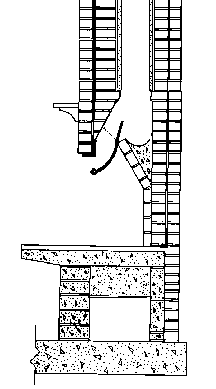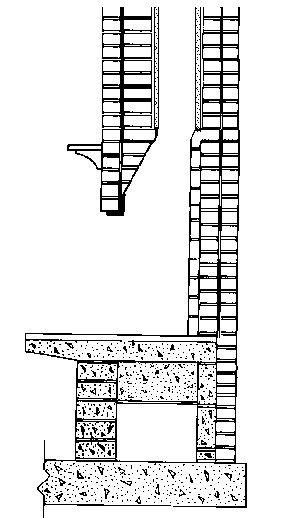Spillage from open fireplacesFireplaces without doors present special problems because they provide no barrier between the com bustion chamber and the room. Whether they are woodburning or have a gas log, open fireplaces operate within a narrow band between successful venting and spillage. A small amount of room depressurization, or even the moving air currents produced by someone walking briskly in front of the opening, can be enough to cause spillage. There are several reasons why open fireplaces seem so fussy today despite the fact that they were used as the sole source of heat for many houses as recently as a century ago. Historically, the chimney was contained within the building envelope, the envelope was leaky, the venting system was massive and was kept warm around the clock because the fireplace was the sole source of heat. All of these factors contributed to reliable venting, even with an open fireplace. Influence of a tight envelopeThe most commonly cited reason for spillage is the more airtight house construction that has become increasingly common over the past 20 years. An open fireplace consumes a large volume of room air beyond that required for combustion (referred to as excess air) in order to flow combustion gases up the chimney instead of into the room. Excess air levels are regularly between 10 and 20 times the amount needed for combustion. The envelope of a tightly constructed house resists the infiltration of this much air. The result is that the fireplace can starve for air and some smoke may escape into the room. Although the flow resistance of a tight building envelope is a key factor in many cases of venting failure in open fireplaces, it is by no means the only cause. Masonry fireplace design
From an aerodynamic perspective, the traditional fireplace design is all wrong. Factory-built fireplaces are often more resistant to spillage than masonry versions because of their more appropriate internal shape: a domed firebox ceiling and centrally located round flue. Nevertheless, all open fireplaces, whether factory-built or masonry, are susceptible to spillage, particularly during fire kindling and tail-out periods. The tighter envelopes of modern houses just make matters worse. There is no single best remedial measure for open fireplaces that spill. This is because of the wide range of taste in fireplace design and in the perceived need for a functioning hearth among the homeowners. Although it is conceivable that any fireplace could be made to work in any building, the cost in some cases would surely be prohibitive. The most obvious, effective and inexpensive remedial measure for a troubled open fireplace is to install a set of glass doors. The presence of this barrier between the firebox and the room makes the fireplace far more resistant to spillage and reduces its excess air consumption. The installation of an EPA certified wood burning fireplace insert is even more effective than glass doors, provided the installation includes stainless steel chimney liner running to the top of the masonry chimney. Another viable option is a direct vent gas insert. Despite the effectiveness of glass doors and fireplace inserts, they are not acceptable in some situations because the householder demands historical accuracy or simply wants the aesthetics of an open hearth. This discussion of remedial measures assumes that the glass door and fireplace insert options have been offered to the customer and rejected. If the fireplace is prone to cold backdraft because it is located well below the neutral pressure plane and because the chimney is outside or is effectively shorter than the house envelope, the right strategy is to solve the cold backdraft first. An open fireplace that cold backdrafts in addition to the other inherent problems will be almost impossible to operate without smoke spillage. On the other hand, an open fireplace that vents properly at standby is much more likely to operate successfully, and even if there are spillage problems, corrective measures may be effective. While other strategies are able to mask the cold backdraft problem, only by enclosing the chimney within the house envelope can the cause of the backdraft be eliminated. If enclosing the chimney within the house envelope is not practical or the expense cannot be justified, a less desirable but potentially effective method that can be called seal at standby/pressurize at start-up could be considered. This option does not require renovations to the house, but does not fully resolve the problem of the cold hearth. It is a two-step strategy:
In this scenario, the chimney damper prevents a cold backdraft and the make-up air system causes the room to be pressurized while a fire is built and chimney draft is established. If the fireplace is large and the building envelope is tight, the make-up air system may have to operate continuously while the fireplace is used to prevent air starvation. It would certainly need to be used continuously if there were other spillage-susceptible combustion equipment in the house, such as a conventional gas furnace or water heater. Note that the make-up air system would be installed in the basement or in a utility room, but the control switch could be located near the fireplace. It is rarely necessary to "place" the make-up air near the exhausting appliance, although, considering the volume of make-up air required by an open fireplace, the supply outlet should be on the same level of the house and should not be separated from the fireplace by tight fitting interior doors. Theoretically, once the householders had been informed of the correct use of the system, they could build a fire at any time without fear of smoke spillage, and they would not have to put up with the cold hearth syndrome. The main disadvantage, and potential danger, of this approach is that the core problem of cold backdraft has not been corrected. The system could revert to cold back draft during a receding fire if the chimney were being severely chilled. A cold backdraft on an active coal bed can result in the spillage of a significant quantity of carbon monoxide. This is not just a theoretical possibility, but is one of the more common failure modes of severely troubled open systems. Another problem, although less serious, occurs when the fireplace is not being used and the chimney-top damper is closed. By sealing the flue at the top, a top damper stops outdoor air from flowing down the chimney, but permits a convection current of room air to flow within the chimney. This flow of air not only brings cool air into the room, it also brings hearth odors. If glass doors are not an acceptable option, hearth deodorizing chemicals, available from specialty hearth dealers, can help to control odors from unused fireplaces. The decision as to the viability of this option would be based on the amount of use the fireplace was likely to get and on the severity of the cold backdraft. If the backdraft is chronic and powerful, this option should not be recommended. A couple of remedial strategies are available for a fireplace that does not cold backdraft but from which smoke rolls out during operation.
The ratio of the flue area to the area of the fireplace opening is one aspect of masonry fireplace design that is regulated by most building codes. The codes usually provide tables of flue sizes for various opening sizes. The tables in some codes include guidelines for flue size based on a range of chimney height and for chimneys with insulated flues. The basis of the tables, however, is simple ratios of firebox opening area to flue area. These normally range from a ratio of 10:1 for short, uninsulated chimneys to as much as 19:1 for tall chimneys that are insulated. Where the resistance offered by a flue area that is too small for the firebox opening is judged to be the cause of spillage, the standard remedial measure is to make the firebox opening smaller, since it is difficult if not impossible to make an existing chimney larger. In general, however, it is better to correct any internal restrictions, such as the design of the damper and smoke shelf before dealing with what appears to be a flue of inadequate area. Field experience has shown that a fireplace with a smooth, conical dome above the firebox can perform well with a relatively small flue. Fireplaces with more than one face open to the room are particularly prone to spillage. Open fireplace designs, such as two-sided see-through, three-sided bay or peninsula, or four-sided will only work under perfectly ideal conditions. Just because architects, builders and home buyers like such designs for aesthetic appeal and decorating possibilities, does not mean they are practical or technically feasible in modern housing. When such a fireplace design is proposed, those involved should be warned in clear terms that smoke spillage is extremely likely. Clearly stating this warning is a key responsibility of qualified hearth or housing personnel. If all other remedial measures fail to control smoke roll-out, the final option is to pressurize the building while the fireplace is operating. This less-than-elegant solution should not be recommended except in cases in which the need to have an functioning open fireplace outweighs the disadvantages. The disadvantages include the cost of additional energy consumed, the challenge of training the householders in the use of the system, and the inherent problems of both fully manual switches and timers. It could be argued with some validity that open fireplaces are not compatible with modern housing. As building envelopes become more tightly sealed for comfort and energy conservation reasons, the operation of open fireplaces becomes more problematic. An "off the shelf" open fireplace design is almost certain to suffer venting failure in a tight house. To vent successfully in a house with a tight envelope, an open fireplace would have to be of perfect design in all respects AND be combined with a sophisticated house pressure management system. Instead of the "prescriptive" approach to fireplace design found in most building codes, open fireplace installations need to be engineered to account for the particular characteristics of the house and the fireplace. A "performance" based requirement for open hearths would put the onus on the designer/installer to prove through testing that the system would function safely in the house environment. Summary
Back to the Table of Contents |

